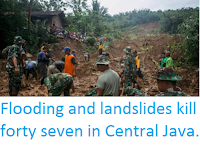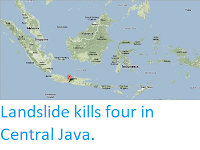Seven people are known to have died and at least thirteen more are missing following a landslide that hit the village of Pasir Panjang in the Brebes District of Central Java, Indonesia, on Thursday 22 February 2018. Several more people needed hospital treatment after the event, which has displaced about 250 people from their homes. The incident is reported to have occurred when a soil slope above the village after about two weeks of heavy rain in the area. Landslides are a common problem after severe weather events, as excess
pore water pressure can overcome cohesion in soil and sediments,
allowing them to flow like liquids. Approximately 90% of all landslides
are caused by heavy rainfall.
Damage to buildings in the village of Pasir Panjang in Central Java, following the 22 February 2018 landslip. Oky Lukmansyah/Antara Foto/Reuters.
Landslides are a common problem in Java, particularly during the Northeast Monsoon, which lasts from November to February, with peak rainfall in January and February, and can result in an annual
rainfall of around of 4000 mm in parts of Central Java. This problem has been made worse as expanding populations
has led to people farming higher on hillslopes, in an area where soils
tend to be volcanic in action and poorly consolidated (i.e. lack much
cohesion), making them more prone to landslides.
Monsoons
are tropical sea breezes triggered by heating of the land during the
warmer part of the year (summer). Both the land and sea are warmed by
the Sun, but the land has a lower ability to absorb heat, radiating it
back so that the air above landmasses becomes significantly warmer than
that over the sea, causing the air above the land to rise and drawing in
water from over the sea; since this has also been warmed it carries a
high evaporated water content, and brings with it heavy rainfall. In the
tropical dry season the situation is reversed, as the air over the land
cools more rapidly with the seasons, leading to warmer air over the
sea, and thus breezes moving from the shore to the sea (where air is
rising more rapidly) and a drying of the climate.
Diagrammatic representation of wind and rainfall patterns in a tropical monsoon climate. Geosciences/University of Arizona.
Java has two distinct Monsoon Seasons, with a Northeast Monsoon driven
by winds from the South China Sea that lasts from November to February
and a Southwest Monsoon driven by winds from the southern Indian Ocean from March to October. Such a double Monsoon Season is common
close
to the equator, where the Sun is highest overhead around the equinoxes
and lowest on the horizons around the solstices, making the solstices
the coolest part of the year and the equinoxes the hottest.
The winds that drive the Northeast and Southwest Monsoons in Southeast Asia. Mynewshub.
See also...
Follow Sciency Thoughts on Facebook.










